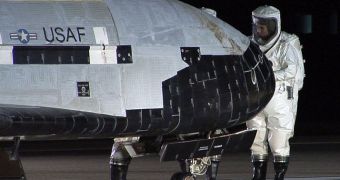Officials in the United States are currently getting ready for the upcoming launch of the second unmanned X-37B spacecraft. The craft, which many believes acts as a spy plane in orbit, comes shortly after the successful landing of the first X-37B.
Officially, it is called the US Air Force X-37B Orbital Test Vehicle (OTV)-2. Originally, the project was developed at NASA, but then it was taken over by the Pentagon, and then handed over to another actor.
The X-37B then arrived at the Defense Advanced Research Projects Agency (DARPA). Ultimately, the USAF got a hold of it, and finally managed to launch the first one last year, SpaceRef reports.
OTV-1 took off on April 22, 2010 from the Cape Canaveral Air Force Station (CCAFS), in Florida. It soared to orbit aboard an Atlas V delivery system, and remained there until December 3.
After spending more than 224 days of non-stop operations in various low-Earth orbits (LEO), the spacecraft made a triumphant return to Earth. It landed on Runway 12 at the Vandenberg Air Force Base (VAFB) in California.
Encouraged by the success of the first X-37B, the USAF began preparing the second vehicle, and there is now talk of a third one. At this point, the launch date for OTV-2 has been set to Friday, March 4.
The vehicle will be carried to space aboard an Atlas V Evolved Expendable launch system, that will take off from the CCAFS Space Launch Complex 41 (SLC-41). The launch window for Friday begins at around 3:39 pm EST (1839 GMT).
Officially, the role of the X-37B is to provide the USAF with a flexible test platform in space, that could be used to try out new technologies. These include propulsion, orbital imaging, remote sensing and so on.
But amateur astronomers and satellite trackers that kept an eye on the first spacecraft say that could also act like a spy plane. The orbit it changed during the maiden flight would certainly seem to indicate that, they explain.
The OTV-2 has all the prerequisites for success. Its engineers are confident in the machine, especially given that the first flight was such a success. They say that the experience they accumulated during that launch will come in handy on Friday.
According to USAF representatives, the Force plans to construct three X-37B, and operate them either simultaneously, or alternatively. A clear schedule of this has not yet been set, but USAF spokespersons made it clear that it's doubtful the general public will be informed on this issue.

 14 DAY TRIAL //
14 DAY TRIAL //